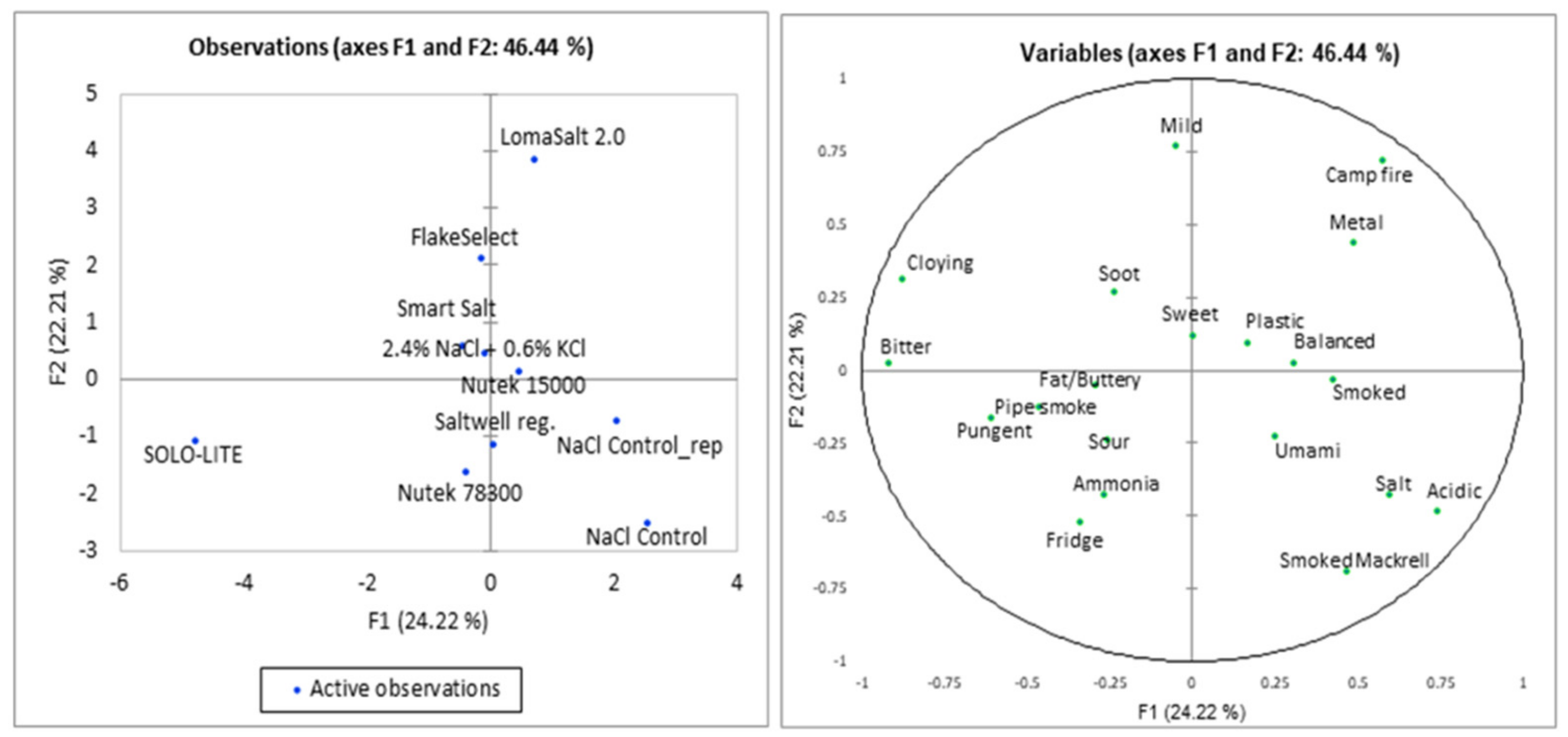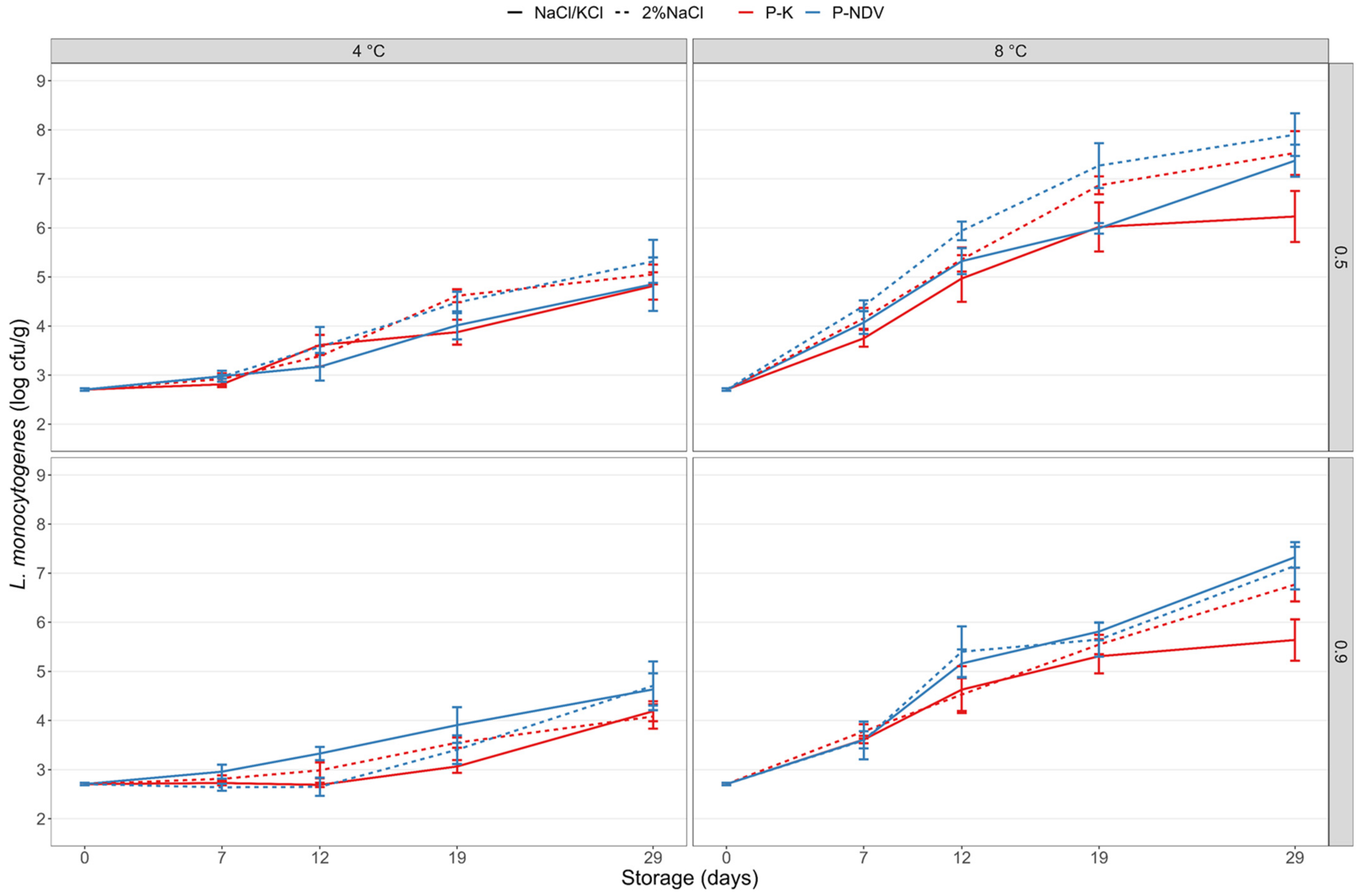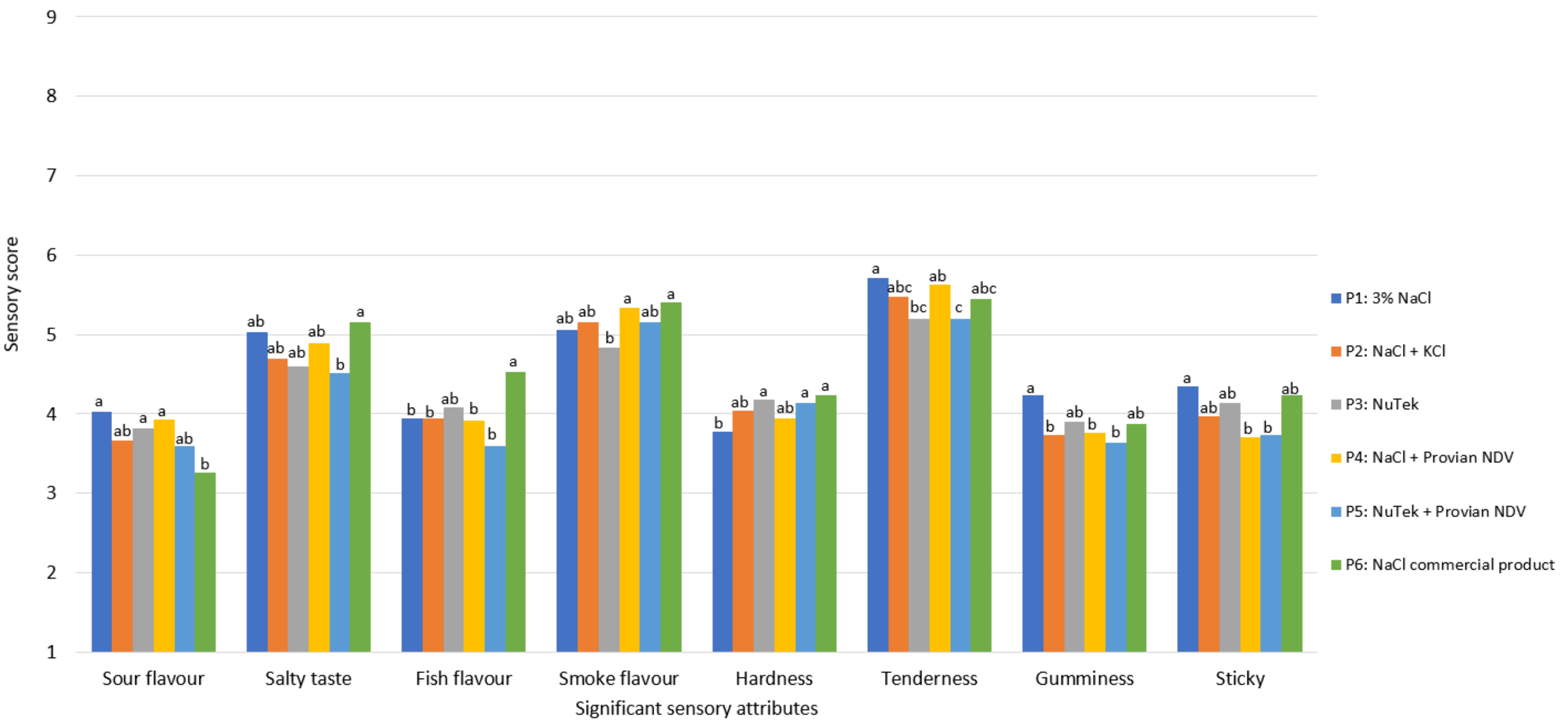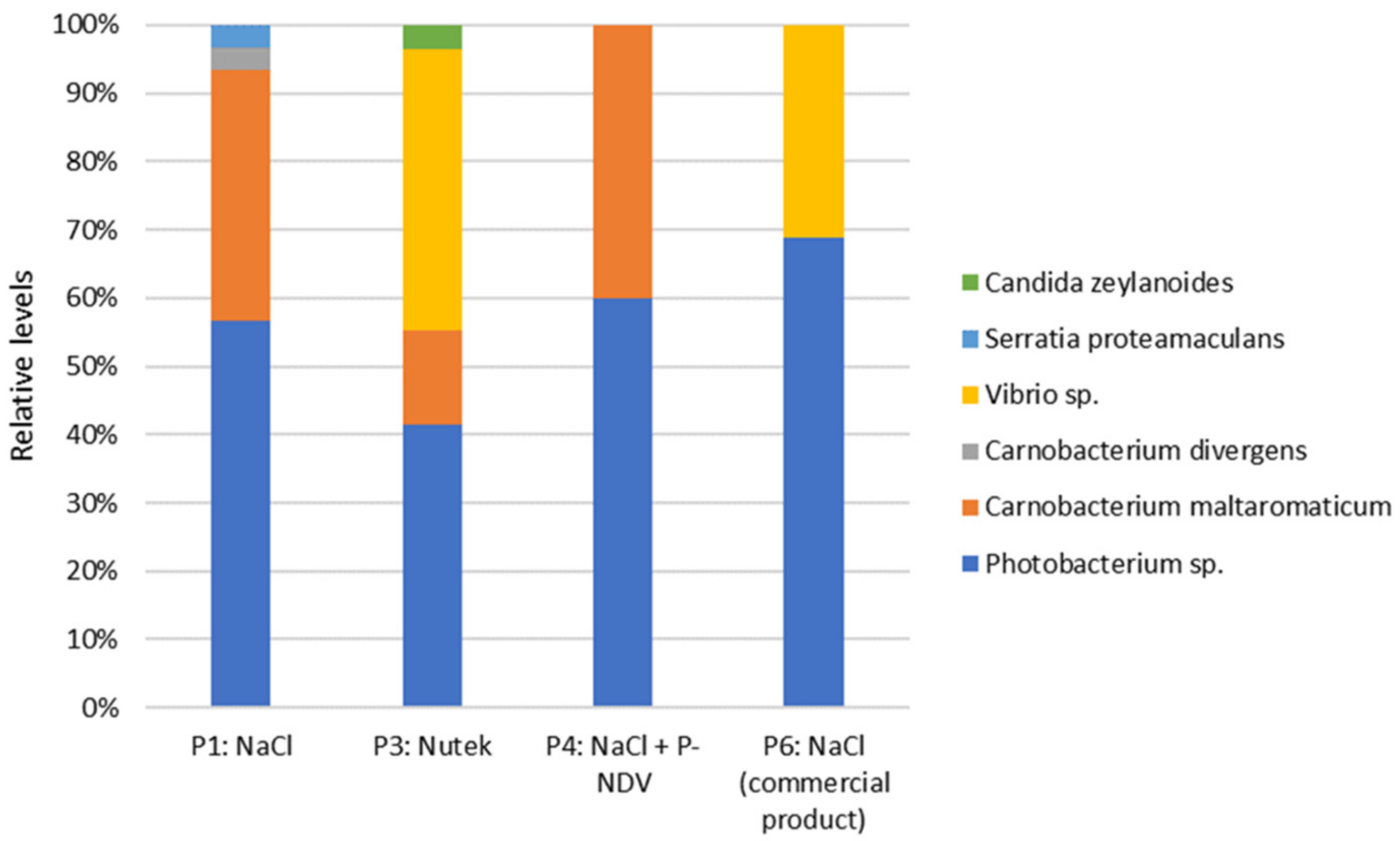Microbial Safety and Sensory Analyses of Cold-Smoked Salmon Produced with Sodium-Reduced Mineral Salts and Organic Acid Salts
Abstract
:1. Introduction
2. Materials and Methods
2.1. Mineral Salts and Organic Acid Salts
2.2. Production of Cold-Smoked Salmon with Salt Replacers
2.2.1. Salmon Produced for Screening the Sensory Effects of Salt Replacers
2.2.2. Salmon Produced for L. monocytogenes Challenge Tests
2.2.3. Industrially Produced Salmon
2.3. Sensory Analyses
2.3.1. Sensory Screening by Projective Mapping of CS Salmon with Salt Replacers
2.3.2. Sensory Descriptive Analyses of Industrially Produced CS Salmon with Salt Replacers
| Product No. | Salt Mixture 1 | Added NaCl, KCl, Total Mineral Salts (%) 2 | Added Provian-NDV salt (%) 2 | Measured Product Characteristics and Salt Uptake (%) 3 | |||||||
|---|---|---|---|---|---|---|---|---|---|---|---|
| NaCl | KCl | Total | NaCl | % NaCl Uptake | KCl | % KCl Uptake | Acetate | % Acetate Uptake 3,4 | |||
| P1 | NaCl | 4.13 | 0 | 4.13 | 0 | 1.89 | 46 | ND | ND | 0.01 ± 0.002 | ND |
| P2 | NaCl + KCl | 2.89 | 1.24 | 4.13 | 0 | 1.46 | 51 | 0.62 ± 0.03 | 50 | ND | ND |
| P3 | Nutek 78300 | 2.89 | 1.24 | 4.13 | 0 | 1.86 | 64 | 0.68 ± 0.07 | 55 | ND | ND |
| P4 | NaCl + P-NDV | 4.13 | 0 | 4.13 | 1.24 | 1.51 | 37 | ND | ND | 0.17 ± 0.1 | 23 |
| P5 | Nutek 78300 + P-NDV | 2.89 | 1.24 | 4.13 | 1.24 | 1.65 | 57 | 0.68 5 | 55 | 0.23 ± 0.1 | 31 |
| P6 | Standard product 6 | ND | 0 | ND | 0 | 2.48 | ND | ND | ND | ND | ND |
2.4. Listeria monocytogenes Challenge Tests
2.4.1. L. monocytogenes Strains and Culture Conditions
2.4.2. L. monocytogenes Contamination and Growth in CS Salmon
2.5. Microbiological Analyses and Bacterial Identification
2.6. Physiochemical Analyses
2.7. Experimental Design and Statistical Analyses
3. Results
3.1. Sensory Screening of CS Salmon with Sodium Reduced Salt Replacers
3.2. Growth of L. monocytogenes in CS Salmon Produced with NaCl and Selected Salt Replacers
3.3. Effects of Organic Acid Based Preservative Salts on the Growth of L. monocytogenes in Sodium-Reduced CS Salmon
3.4. Physiochemical Characteristics of Salmon with Sodium-Reduced Salt Replacers and Organic Acid Salt Preservatives
3.5. Sensory and Chemical Properties of Industrially Produced CS Salmon with Salt Replacers and Acetate Containing Preservative Salts
3.6. Growth of L. monocytogenes in Industrially Produced CS Salmon
3.7. Effects of Sodium-Reduced Salt Replacers on the Indigenous Microbiota
4. Discussion
Supplementary Materials
Author Contributions
Funding
Institutional Review Board Statement
Informed Consent Statement
Data Availability Statement
Acknowledgments
Conflicts of Interest
References
- Mozaffarian, D.; Fahimi, S.; Singh, G.M.; Micha, R.; Khatibzadeh, S.; Engell, R.E.; Lim, S.; Danaei, G.; Ezzati, M.; Powles, J.; et al. Global sodium consumption and death from cardiovascular causes. N. Engl. J. Med. 2014, 371, 624–634. [Google Scholar] [CrossRef] [PubMed] [Green Version]
- Webb, M.; Fahimi, S.; Singh, G.M.; Khatibzadeh, S.; Micha, R.; Powles, J.; Mozaffarian, D. Cost effectiveness of a government supported policy strategy to decrease sodium intake: Global analysis across 183 nations. BMJ 2017, 356, i6699. [Google Scholar] [CrossRef] [Green Version]
- Aburto, N.J.; Ziolkovska, A.; Hooper, L.; Elliott, P.; Cappuccio, F.P.; Meerpohl, J.J. Effect of lower sodium intake on health: Systematic review and meta-analyses. BMJ 2013, 346, f1326. [Google Scholar] [CrossRef] [PubMed] [Green Version]
- Salt Reduction. Available online: https://www.who.int/news-room/fact-sheets/detail/salt-reduction (accessed on 12 May 2022).
- European Commission. Survey on Member States’ Implementation of the EU Salt Reduction Framework. European Commission. 2014. Available online: https://data.europa.eu/doi/10.2772/50212 (accessed on 23 April 2022).
- Turck, D.; Castenmiller, J.; de Henauw, S.; Hirsch-Ernst, K.-I.; Kearney, J.; Knutsen, H.K.; Maciuk, A.; Mangelsdorf, I.; McArdle, H.J.; Pelaez, C. Dietary reference values for sodium. EFSA J. 2019, 17, e05778. [Google Scholar] [CrossRef] [Green Version]
- Allison, A.; Fouladkhah, A. Adoptable interventions, human health, and food safety considerations for reducing sodium content of processed food products. Foods 2018, 7, 16. [Google Scholar] [CrossRef] [PubMed] [Green Version]
- Trieu, K.; Neal, B.; Hawkes, C.; Dunford, E.; Campbell, N.; Rodriguez-Fernandez, R.; Legetic, B.; McLaren, L.; Barberio, A.; Webster, J. Salt reduction initiatives around the world—A systematic review of progress towards the global target. PLoS ONE 2015, 10, e0130247. [Google Scholar] [CrossRef] [PubMed] [Green Version]
- The Keyhole—For Healthier Food. Available online: https://www.helsenorge.no/en/kosthold-og-ernaring/keyhole-healthy-food (accessed on 12 May 2022).
- Mejlholm, O.; Gunvig, A.; Borggaard, C.; Blom-Hanssen, J.; Mellefont, L.; Ross, T.; Leroi, F.; Else, T.; Visser, D.; Dalgaard, P. Predicting growth rates and growth boundary of Listeria monocytogenes—An international validation study with focus on processed and ready-to-eat meat and seafood. Int. J. Food Microbiol. 2010, 141, 137–150. [Google Scholar] [CrossRef] [PubMed] [Green Version]
- Giese, E.; Meyer, C.; Ostermeyer, U.; Lehmann, I.; Fritsche, J. Sodium reduction in selected fish products by means of salt substitutes. Eur. Food Res. Technol. 2019, 245, 1651–1664. [Google Scholar] [CrossRef]
- Almli, V.L.; Hersleth, M. Salt replacement and injection salting in smoked salmon evaluated from descriptive and hedonic sensory perspectives. Aquac. Int. 2013, 21, 1091–1108. [Google Scholar] [CrossRef]
- Buchanan, R.L.; Gorris, L.G.M.; Hayman, M.M.; Jackson, T.C.; Whiting, R.C. A review of Listeria monocytogenes: An update on outbreaks, virulence, dose-response, ecology, and risk assessments. Food Control 2017, 75, 1–13. [Google Scholar] [CrossRef]
- EFSA (European Food Safety Authority). Analysis of the baseline survey on the prevalence of Listeria monocytogenes in certain ready-to-eat foods in the EU, 2010–2011 Part A: Listeria monocytogenes prevalence estimates. EFSA J. 2013, 11, 3241. [Google Scholar] [CrossRef]
- Hoffmann, S.; Batz, M.B.; Morris, J.G. Annual cost of illness and quality-adjusted life year losses in the United States due to 14 foodborne pathogens. J. Food Prot. 2012, 75, 1292–1302. [Google Scholar] [CrossRef] [PubMed]
- Lomonaco, S.; Nucera, D.; Filipello, V. The evolution and epidemiology of Listeria monocytogenes in Europe and the United States. Infect. Genet. Evol. 2015, 35, 172–183. [Google Scholar] [CrossRef] [PubMed]
- Albarracin, W.; Sanchez, I.C.; Grau, R.; Barat, J.M. Salt in food processing; usage and reduction: A review. Int. J. Food Sci. 2011, 46, 1329–1336. [Google Scholar] [CrossRef]
- Cepanec, K.; Vugrinec, S.; Cvetkovic, T.; Ranilovic, J. Potassium chloride-based salt substitutes: A critical review with a focus on the patent literature. Compr. Rev. Food Sci. Food Saf. 2017, 16, 881–894. [Google Scholar] [CrossRef] [Green Version]
- Munoz, I.; Guardia, M.D.; Arnau, J.; Dalgaard, P.; Bover, S.; Fernandes, J.O.; Monteiro, C.; Cunha, S.C.; Goncalves, A.; Nunes, M.L.; et al. Effect of the sodium reduction and smoking system on quality and safety of smoked salmon (Salmo salar). Food Chem. Toxicol. 2020, 143, 111554. [Google Scholar] [CrossRef]
- Rybicka, I.; Gonçalves, A.; Oliveira, H.; Marques, A.; Nunes, M.L. Salt reduction in seafood—A review. Food Control 2022, 135, 108809. [Google Scholar] [CrossRef]
- Barat, J.M.; Perez-Esteve, E.; Aristoy, M.C.; Toldra, F. Partial replacement of sodium in meat and fish products by using magnesium salts. A review. Plant Soil 2013, 368, 179–188. [Google Scholar] [CrossRef]
- Vidal, V.A.S.; Lorenzo, J.M.; Munekata, P.E.S.; Pollonio, M.A.R. Challenges to reduce or replace NaCl by chloride salts in meat products made from whole pieces—A review. Crit. Rev. Food Sci. Nutr. 2021, 61, 2194–2206. [Google Scholar] [CrossRef]
- Norwegian Scientific Committee for Food Safety. Benefit and Risk Assessment of Increasing Potassium by Replacement of Sodium Chloride with Potassium Chloride in Industrial Food Production; VKM Report 2014: 27; Norwegian Scientific Committee for Food Safety: Oslo, Norway, 2014. [Google Scholar]
- Potassium-Based Sodium Replacers: Assessment of the Health Benefits and Risks of Using Potassium Based Sodium Replacers in Foods in the UK. A Joint Statement from the Scientific Advisory Committee on Nutrition and the Committee on Toxicity of Chemicals in Food, Consumer Products and the Environment. Available online: https://assets.publishing.service.gov.uk/government/uploads/system/uploads/attachment_data/file/660526/SACN_COT_-_Potassium-based_sodium_replacers.pdf (accessed on 12 May 2022).
- Boziaris, I.S.; Skandamis, P.N.; Anastasiadi, M.; Nychas, G.J.E. Effect of NaCl and KCl on fate and growth/no growth interfaces of Listeria monocytogenes Scott A at different pH and nisin concentrations. J. Appl. Microbiol. 2007, 102, 796–805. [Google Scholar] [CrossRef]
- Heir, E.; Liland, K.H.; Carlehog, M.; Holck, A.L. Reduction and inhibition of Listeria monocytogenes in cold-smoked salmon by Verdad N6, a buffered vinegar fermentate, and UV-C treatments. Int. J. Food Microbiol. 2019, 291, 48–58. [Google Scholar] [CrossRef] [PubMed]
- Robb, D.H.F. Measurement of fish flesh colour. In Farmed Fish Quality; Kestin, S., Warriss, P., Eds.; Blackwell Scientific Ltd.: London, UK, 2001; pp. 298–306. [Google Scholar]
- Risvik, E.; McEwan, J.A.; Colwill, J.S.; Rogers, R.; Lyon, D.H. Projective mapping: A tool for sensory analysis and consumer research. Food Qual. Prefer. 1994, 5, 263–269. [Google Scholar] [CrossRef]
- Pages, J. Collection and analysis of perceived product inter-distances using multiple factor analysis: Application to the study of 10 white wines from the Loire Valley. Food Qual. Prefer. 2005, 16, 642–649. [Google Scholar] [CrossRef]
- Lawless, H.T.; Heymann, H. Sensory Evaluation of Food—Principles and Practices, 2nd ed.; Springer Science & Business Media: New York, NY, USA, 2010. [Google Scholar]
- Nutrition Facts Search Tool. Available online: https://tools.myfooddata.com/nutrition-facts (accessed on 12 May 2022).
- Møretrø, T.; Schirmer, B.C.T.; Heir, E.; Fagerlund, A.; Hjemli, P.; Langsrud, S. Tolerance to quaternary ammonium compound disinfectants may enhance growth of Listeria monocytogenes in the food industry. Int. J. Food Microbiol. 2017, 241, 215–224. [Google Scholar] [CrossRef] [PubMed] [Green Version]
- Rudi, K.; Zimonja, M.; Hannevik, S.E.; Dromtorp, S.M. Multiplex real-time single nucleotide polymorphism detection and quantification by quencher extension. Biotechniques 2006, 40, 323–329. [Google Scholar] [CrossRef] [PubMed]
- Fugett, E.; Fortes, E.; Nnoka, C.; Wiedmann, M. International Life Sciences Institute North America Listeria monocytogenes strain collection: Development of standard Listeria monocytogenes strain sets for research and validation studies. J. Food Prot. 2006, 69, 2929–2938. [Google Scholar] [CrossRef]
- Cantinelli, T.; Chenal-Francisque, V.; Diancourt, L.; Frezal, L.; Leclercq, A.; Wirth, T.; Lecuit, M.; Brisse, S. “Epidemic clones” of Listeria monocytogenes are widespread and ancient clonal groups. J. Clin. Microbiol. 2013, 51, 3770–3779. [Google Scholar] [CrossRef] [Green Version]
- Møretrø, T.; Moen, B.; Heir, E.; Hansen, A.A.; Langsrud, S. Contamination of salmon fillets and processing plants with spoilage bacteria. Int. J. Food Microbiol. 2016, 237, 98–108. [Google Scholar] [CrossRef] [Green Version]
- AOAC International. Method 976.18, Salt (chlorine and sodium chloride) in seafood. Potentiometric method, in combination with 937.07, Fish and marine products. Treatment and preparation of sample procedure, and 971.27, Sodium chloride in canned vegetables. Potentiometric method. In AOAC Official Methods of Analysis, 17th ed.; AOAC International: Arlington, VA, USA, 2000. [Google Scholar]
- Dalgaard, P.; Jørgensen, L.V. Cooked and brined shrimps packed in a modified atmosphere have a shelf-life of >7 months at 0 °C, but spoil in 4–6 days at 25 °C. Int. J. Food Sci. Technol. 2000, 35, 431–442. [Google Scholar] [CrossRef]
- Mejlholm, O.; Dalgaard, P. Modeling and predicting the growth boundary of Listeria monocytogenes in lightly preserved seafood. J. Food Prot. 2007, 70, 70–84. [Google Scholar] [CrossRef]
- Escofier, B.; Pages, J. Multiple factor-analysis (AFMULT Package). Comput. Stat. Data Anal. 1994, 18, 121–140. [Google Scholar] [CrossRef]
- Hastie, T.J.; Pregibon, D. Generalized linear models. In Statistical Models in S; Chambers, J.M., Hastie, T.J., Eds.; Chapman and Hall/CRC: Boca Raton, FL, USA, 1992. [Google Scholar]
- Venables, W.N.; Ripley, B.D. Modern Applied Statistics with S; Springer: New York, NY, USA, 2002. [Google Scholar]
- R_Core_Team. R: A Language and Environment for Statistical Computing; R Foundation for Statistical Computing: Vienna, Austria, 2021. [Google Scholar]
- Neetoo, H.; Ye, M.; Chen, H. Potential antimicrobials to control Listeria monocytogenes in vacuum-packaged cold-smoked salmon pâté and fillets. Int. J. Food Microbiol. 2008, 123, 220–227. [Google Scholar] [CrossRef] [PubMed]
- Tang, S.L.; Stasiewicz, M.J.; Wiedmann, M.; Boor, K.J.; Bergholz, T.M. Efficacy of different antimicrobials on inhibition of Listeria monocytogenes growth in laboratory medium and on cold-smoked salmon. Int. J. Food Microbiol. 2013, 165, 265–275. [Google Scholar] [CrossRef] [PubMed]
- Rizo, A.; Fuentes, A.; Barat, J.M.; Fernandez-Segovia, I. Development of a novel smoke-flavoured salmon product by sodium replacement using water vapour permeable bags. J. Sci. Food Agric. 2018, 98, 2721–2728. [Google Scholar] [CrossRef]
- Rizo, A.; Fuentes, A.; Fernandez-Segovia, I.; Barat, J.M. Development of a novel smoke-flavoured trout product: An approach to sodium reduction and shelf life assessment. J. Food Eng. 2017, 211, 22–29. [Google Scholar] [CrossRef]
- Gomes, M.D.A.; Kato, L.S.; de Carvalho, A.P.A.; de Almeida, A.; Conte-Junior, C.A. Sodium replacement on fish meat products—A systematic review of microbiological, physicochemical and sensory effects. Trends Food Sci. Technol. 2021, 118, 639–657. [Google Scholar] [CrossRef]
- Bidlas, E.; Lambert, R.J.W. Comparing the antimicrobial effectiveness of NaCl and KCl with a view to salt/sodium replacement. Int. J. Food Microbiol. 2008, 124, 98–102. [Google Scholar] [CrossRef] [Green Version]
- Gimenez, B.; Dalgaard, P. Modelling and predicting the simultaneous growth of Listeria monocytogenes and spoilage micro-organisms in cold-smoked salmon. J. Appl. Microbiol. 2004, 96, 96–109. [Google Scholar] [CrossRef]
- Lakshmanan, R.; Dalgaard, P. Effects of high-pressure processing on Listeria monocytogenes, spoilage microflora and multiple compound quality indices in chilled cold-smoked salmon. J. Appl. Microbiol. 2004, 96, 398–408. [Google Scholar] [CrossRef] [Green Version]
- Mejlholm, O.; Dalgaard, P. Modeling and predicting the growth of lactic acid bacteria in lightly preserved seafood and their inhibiting effect on Listeria monocytogenes. J. Food Prot. 2007, 70, 2485–2497. [Google Scholar] [CrossRef]
- Mejlholm, O.; Kjeldgaard, J.; Modberg, A.; Vest, M.B.; Boknaes, N.; Koort, J.; Bjorkroth, J.; Dalgaard, P. Microbial changes and growth of Listeria monocytogenes during chilled storage of brined shrimp (Pandalus borealis). Int. J. Food Microbiol. 2008, 124, 250–259. [Google Scholar] [CrossRef] [PubMed]
- Gram, L.; Dalgaard, P. Fish spoilage bacteria—Problems and solutions. Curr. Opin. Biotechnol. 2002, 13, 262–266. [Google Scholar] [CrossRef]
- Hansen, L.T.; Rontved, S.D.; Huss, H.H. Microbiological quality and shelf life of cold-smoked salmon from three different processing plants. Food Microbiol. 1998, 15, 137–150. [Google Scholar] [CrossRef]
- Leroi, F.; Joffraud, J.J.; Chevalier, F.; Cardinal, M. Study of the microbial ecology of cold-smoked salmon during storage at 8 degrees C. Int. J. Food Microbiol. 1998, 39, 111–121. [Google Scholar] [CrossRef]
- Olofsson, T.C.; Ahrne, S.; Molin, G. The bacterial flora of vacuum-packed cold-smoked salmon stored at 7 degrees C, identified by direct 16S rRNA gene analysis and pure culture technique. J. Appl. Microbiol. 2007, 103, 109–119. [Google Scholar] [CrossRef]
- Jorgensen, L.V.; Huss, H.H.; Dalgaard, P. The effect of biogenic amine production by single bacterial cultures and metabiosis on cold-smoked salmon. J. Appl. Microbiol. 2000, 89, 920–934. [Google Scholar] [CrossRef]









| Treatment No. | Salt Mixture 1 | Experiments Where Applied | Added NaCl, KCl, Total Mineral Salts (%) 2 | Proportion of KCl and Other Non-NaCl Mineral Salts in Mix | Added Organic Acid Salt (%) 2 | Measured Product Characteristics | ||||||
|---|---|---|---|---|---|---|---|---|---|---|---|---|
| NaCl | KCl | Total | Total Mineral Salts (% of Fish) 3 | Total Mineral Salts Uptake (%) 4 | Acetate (%) | Acetate Uptake (%) 5 | Phenol (ppm) | |||||
| 1 | NaCl (control) | S; L | 3.0 | - | 3.0 | - | - | 2.2 ± 0.1 | 72 | - | - | 3.66 |
| 2 | NaCl + KCl | S; L | 2.4 | 0.6 | 3.0 | 20% KCl | - | 2.5 ± 0.2 | 86 | - | - | - |
| 3 | Nutek 78300 | S; L | 2.1 | 0.9 | 3.0 | 30% KCl | - | 2.9 ± 0.6 | 105 | - | - | - |
| 4 | Smart Salt | S; L | 1.8 | 0.64 | 3.0 | 21.4% KCl; 15.5% MgCl2 | - | 2.9 ± 0.6 | 101 | - | - | - |
| 5 | FlakeSelect | S | 1.5 | 1.5 | 3.0 | 50% KCl; | - | - | - | - | - | - |
| 6 | Lomasalt 2.0 | S | 1.5 | 0.84 | 3.0 | 30% KCl; 22 % MgCO3 | - | - | - | - | - | - |
| 7 | Nutek 15000 | S | 2.1 | 0.9 | 3.0 | 30% KCl | - | - | - | - | - | - |
| 8 | Saltwell Reg. | S | 1.95 | 0.9 | 2.9 | 30% KCl | - | - | - | - | - | - |
| 9 | SOLO-LITE | S | 2.1 | 0.87 | 3.0 | 30% KCl; 1% MgSO4 | - | - | - | - | - | - |
| 10 | NaCl + P-K | L | 3.0 | - | 0.5 | 2.1 ± 0.4 | 71 | 0.2 ± 0.0 | 77 | - | ||
| 11 | NaCl + P-K | L | 3.0 | - | 0.9 | 1.9 ± 0.7 | 68 | 0.4 ± 0.0 | 68 | - | ||
| 12 | NaCl + KCl + P-K | L | 2.4 | 0.6 | 3.0 | 20% KCl | 0.5 | 2.6 ± 0.2 | 92 | 0.3 ± 0.1 | 89 | - |
| 13 | NaCl + KCl + P-K | L | 2.4 | 0.6 | 3.0 | 20% KCl | 0.9 | 2.5 ± 0.3 | 89 | 0.5 ± 0.0 | 79 | - |
| 14 | NaCl + KCl + P-K | L | 2.0 | 0.5 | 2.5 | 20% KCl | 0.5 | 2.3 ± 0.3 | 96 | 0.2 ± 0.0 | 50 | - |
| 15 | NaCl + KCl + P-K | L | 2.0 | 0.5 | 2.5 | 20% KCl | 0.9 | 2.0 ± 0.2 | 85 | 0.4 ± 0.1 | 76 | - |
| 16 | NaCl + P-NDV | L | 3.0 | - | 3.0 | - | 0.5 | 2.6 ± 0.4 | 85 | 0.2 ± 0.1 | 72 | 4.78 |
| 17 | NaCl + P-NDV | L | 3.0 | - | 3.0 | - | 0.9 | 2.7 ± 0.2 | 90 | 0.3 ± 0.1 | 61 | - |
| 18 | NaCl + KCl + P-NDV | L | 2.4 | 0.6 | 3.0 | 20% KCl | 0.5 | 3.1 ± 0.3 | 104 | 0.2 ± 0.0 | 71 | - |
| 19 | NaCl + KCl + P-NDV | L | 2.4 | 0.6 | 3.0 | 20% KCl | 0.9 | 2.7 ± 0.2 | 94 | 0.3 ± 0.0 | 57 | - |
| 20 | NaCl + KCl + P-NDV | L | 2.0 | 0.5 | 2.5 | 20% KCl | 0.5 | 3.3 ± 0.7 | 134 | 0.4 ± 0.1 | 119 | - |
| 21 | NaCl + KCl + P-NDV | L | 2.0 | 0.5 | 2.5 | 20% KCl | 0.9 | 2.2 ± 0.2 | 91 | 0.5 ± 0.1 | 82 | 4.19 |
| Strain No. | Serotype | MLVA/ST 1 | Source 2 | Other Designations; Reference |
|---|---|---|---|---|
| MF3860 | 1/2 a | 6-10-5-16-6/20 | Salmon processing, Plant S4 | [32] |
| MF3939 | 1/2 a | 5-8-15-10-6/14 | Salmon processing, Plant S3 | [32] |
| MF4001 | 1/2 a | 5-8-15-10-6/14 | Salmon processing, Plant S2 | [32] |
| MF4077 | 1/2 a | 6-9-18-16-6/8 | Salmon processing, Plant S1 | [32] |
| MF4588 | 1/2 a | 7-7-10-10-6/7 | Salmon processing, Plant S1 | [32] |
| MF4804 | 1/2 a | 6-7-14-10-6/121 | Salmon processing, Plant S2 | [32] |
| MF2184 | 1/2 b | 7-8-0-16-0/3 | Meat processing, outbreak | 2583/92; [33] |
| MF3009 | 1/2 b | n.d./5 | Cattle | FSL J2-064; [34,35] |
| MF3039 | 4 b | n.d./6 | Human, cerebrospinal fluid, outbreak | FSL N1-227; [34,35] |
| MF3710 | 4 b | 7-7-20-6-10/n.d. | Human, cerebrospinal fluid | CCUG3998; Culture Collection University of Gothenburg |
Publisher’s Note: MDPI stays neutral with regard to jurisdictional claims in published maps and institutional affiliations. |
© 2022 by the authors. Licensee MDPI, Basel, Switzerland. This article is an open access article distributed under the terms and conditions of the Creative Commons Attribution (CC BY) license (https://creativecommons.org/licenses/by/4.0/).
Share and Cite
Heir, E.; Jacobsen, M.; Gaarder, M.Ø.; Berget, I.; Dalgaard, P.; Jensen, M.R.; Holck, A.L. Microbial Safety and Sensory Analyses of Cold-Smoked Salmon Produced with Sodium-Reduced Mineral Salts and Organic Acid Salts. Foods 2022, 11, 1483. https://doi.org/10.3390/foods11101483
Heir E, Jacobsen M, Gaarder MØ, Berget I, Dalgaard P, Jensen MR, Holck AL. Microbial Safety and Sensory Analyses of Cold-Smoked Salmon Produced with Sodium-Reduced Mineral Salts and Organic Acid Salts. Foods. 2022; 11(10):1483. https://doi.org/10.3390/foods11101483
Chicago/Turabian StyleHeir, Even, Maria Jacobsen, Mari Øvrum Gaarder, Ingunn Berget, Paw Dalgaard, Merete Rusås Jensen, and Askild L. Holck. 2022. "Microbial Safety and Sensory Analyses of Cold-Smoked Salmon Produced with Sodium-Reduced Mineral Salts and Organic Acid Salts" Foods 11, no. 10: 1483. https://doi.org/10.3390/foods11101483
APA StyleHeir, E., Jacobsen, M., Gaarder, M. Ø., Berget, I., Dalgaard, P., Jensen, M. R., & Holck, A. L. (2022). Microbial Safety and Sensory Analyses of Cold-Smoked Salmon Produced with Sodium-Reduced Mineral Salts and Organic Acid Salts. Foods, 11(10), 1483. https://doi.org/10.3390/foods11101483






